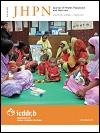Patterns of Alcohol Consumption among Male Adults at a Slum in Kolkata, India
DOI:
https://doi.org/10.3329/jhpn.v30i1.11279Keywords:
Alcohol, Alcohol consumption, Alcohol dependence, Community-based studies, Crosssectional studies, Harmful drinking, Hazardous drinking, IndiaAbstract
Globally, alcohol-abuse is a major cause of mortality and morbidity. Consumption of alcohol has increased in India in the recent decades. It is imperative to know the patterns of alcohol consumption among different types of consumers to launch a well-planned nationwide programme for the prevention and control of this devastating social pathology. This community-based, cross-sectional study was undertaken to identify the patterns of alcohol intake among different types of alcohol consumers and to assess the clinical signs of chronic harmful alcohol-use. A predesigned, pretested, semi-structured alcohol-use disorders identification test (AUDIT) questionnaire was used for interviewing males, aged >18 years, selected by random sampling from an updated household list of a randomly-selected sector of the service area of the Urban Health Centre in Chetla, Kolkata, West Bengal, India. Written informed consents were obtained from all the respondents. Relevant clinical examination for chronic harmful alcohol-use was done according to the AUDIT clinical screening procedures. The results revealed that 65.8% (150/228) were current consumers of alcohol; 14% were alcohol-dependents; 8% were hazardous or harmful consumers, and 78% were nonhazardous non-harmful consumers. The mean age of the respondents at the initiation of drinking alcohol was 20.8+5.9 years. Eighty-six percent of dependents (n=21) took both Indian-made foreign liquor and locally-made alcoholic beverages. The proportions of alcohol consumers who drank alone among alcoholdependents, hazardous or harmful consumers, and non-hazardous non-harmful consumers were 71.4%,50%, and 7.7% respectively, and the difference was significant (p<0.01). Forty-one percent of the consumers drank at public places and workplaces, which may be socially harmful. About 38% of the dependents purchased alcohol from unlicensed liquor shops. Only 16% expressed concerns for their drinking habit mainly to the past illness. The proportion of the concerned respondents was higher in the hazardous and harmful drinking patterns than in the non-hazardous non-harmful drinking pattern, and the difference was significant (p<0.05). About 62% of the dependents had clinical signs of chronic alcohol consumption. The presence of a considerable proportion of alcohol-dependents, the low mean age at initiation of drinking alcohol, and the habit of drinking in public places and workplaces are the main areas that need special emphasis by intervention programmes.
DOI: http://dx.doi.org/10.3329/jhpn.v30i1.11279
J HEALTH POPUL NUTR 2012 Mar;30(1):73-81
Downloads
263
247

